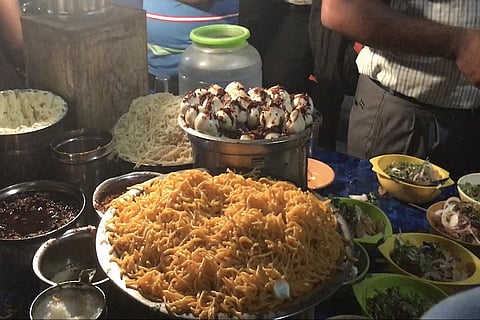

As the sun goes down on Second Line Beach Road near the famed Burma Bazaar in Chennai, kerosene lamps are mounted on pushcarts, huge wide-mouth aluminium buckets heaped with shredded cabbage and carrots are unloaded, and the stoves are lit, their flames burning high.
While street food in Chennai might mean Alsa Mall sandwiches and Ritchie Street samosas to many, this street in Parrys Corner serves Burmese noodle delicacies heaped on small plastic plates.
People from all over the city throng this street specifically for the famed Burmese atho, mohinga and bejo, traditionally prepared by Burmese settlers from the 60s. These Burmese migrants settled in Madras, forming a small colony close to the beach.
As you enter Second Line Beach Street from Mooker Nallamuthu Street in Parrys Corner, the sight of a group of people crowding around a pushcart, digging into plates of noodles and bowls of steaming hot soup greets you. Gajendran Atho Kadai, run by three friends – Gajendran, Radhakrishnan and Vincent – is what is causing all this commotion.
Sacks of cabbage, onion and carrots are unloaded from a mini auto. A boy, crouching next to it, grates the vegetables and piles them into huge metal buckets. As Gajendran takes care of collection, Radhakrishnan ties up his lungi and starts his first batch of atho fry for the day.
Adapted to suit the Indian palate
The Burmese atho that you’ll taste here has been modified for the Indian palate, confides Gajendran, “You won’t find cabbage in the original dish.”
In a wide stainless steel basin, grated carrots, cabbage and fried onions are first tossed followed by a generous helping of garlic oil, chilli powder, salt, masala powder and a dash of lime juice. This is then mixed by hand and topped with a handful of orange noodles and a sprinkling of crumpled crispy bejo and coriander. The bejo is a crispy thattai like snack item made using rice flour and groundnuts. The bejo used here had a beehive like texture.
“Have a couple of spoonfuls like this and then add half a bowl of plantain soup to it. You’ll know the difference,” Vincent calls out to me over the sounds of the evening before handing over the plate. A stainless steel cauldron of plantain soup, containing slices of the stem, keeps boiling throughout the evening, an indispensable combination to the noodles.
While the strong taste of garlic oil and the soft crunch of fried onions are what gives this cold noodle dish its unique taste, a generous helping of hot plantain soup gives it a whole other flavour. As we slurp down bowls of atho that evening, the sky opens up, dousing Chennai in one of its rare late summer rains.
Atho fry, on the other hand, is a hot preparation where cabbage, carrot and onion slices are first tossed in a frying pan. Oodles of garlic oil, masala, salt, chilli powder are added and finally handfuls of atho noodles are added to the pan topped by ladles of a special sauce. Then eggs are cracked into this preparation and the mix is further minced using steel spatulas.
Mohinga, another Burmese delicacy, is a white noodle made using rice flour unlike atho, whose main ingredient is maida. Also, cabbage is the only vegetable used in this preparation. While the Burmese migrants initially used a machine, a lot like our string hopper (idiyappam) making machine, Gajendran says now the noodles are readily available in packs. These noodles are also thicker than the average noodles found in stores.
The stalls also offer masala eggs, another street preparation where boiled eggs are emptied of their yolk and filled with a special masala gravy and fried onions. One plate of atho/mohinga noodles is priced between Rs 60 and Rs 80 in these street-side shops.
While a large portion of the Burmese migrants have moved to different parts of the state, a small colony still remains and religiously serves some of Burmese’s best noodle dishes.
Also Read: